IT Service Management: Ethical Dilemma of Robotic Surgery (ITECH7400)
VerifiedAdded on 2022/09/26
|9
|2122
|25
Discussion Board Post
AI Summary
This assignment delves into the ethical complexities surrounding robotic surgery, a rapidly advancing technology in healthcare. It presents a case study where a patient experienced a near-fatal incident due to a technological failure during a robotic surgery, highlighting the potential risks and ethical dilemmas faced by IT professionals. The student applies four key ethical theories: utilitarianism, deontology, social contract theory, and character-based ethics, to analyze the situation and propose solutions. Furthermore, the assignment examines the application of the ACS (Australian Computer Society) Code of Ethics to the case, assessing the actions of IT professionals against ethical principles like public interest, quality of life enhancement, honesty, competence, professional development, and professionalism. The conclusion emphasizes the importance of balancing technological advancement with ethical considerations and proposes a solution that involves the presence of human doctors during robotic surgeries to guide the robots and ensure patient safety. The assignment is a response to a discussion forum post for the course ITECH7400, IT Service Management and Professional Culture.
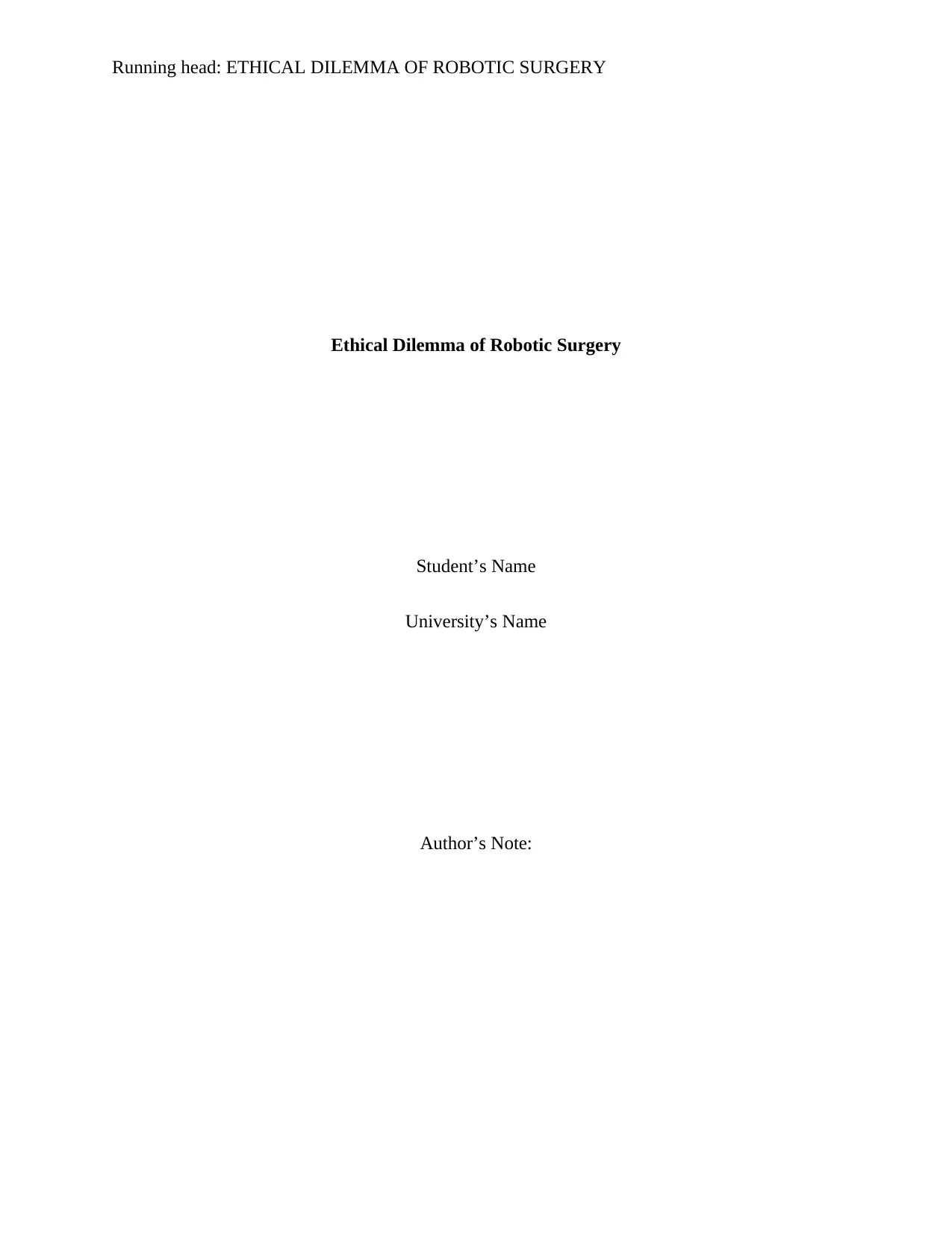
Running head: ETHICAL DILEMMA OF ROBOTIC SURGERY
Ethical Dilemma of Robotic Surgery
Student’s Name
University’s Name
Author’s Note:
Ethical Dilemma of Robotic Surgery
Student’s Name
University’s Name
Author’s Note:
Paraphrase This Document
Need a fresh take? Get an instant paraphrase of this document with our AI Paraphraser
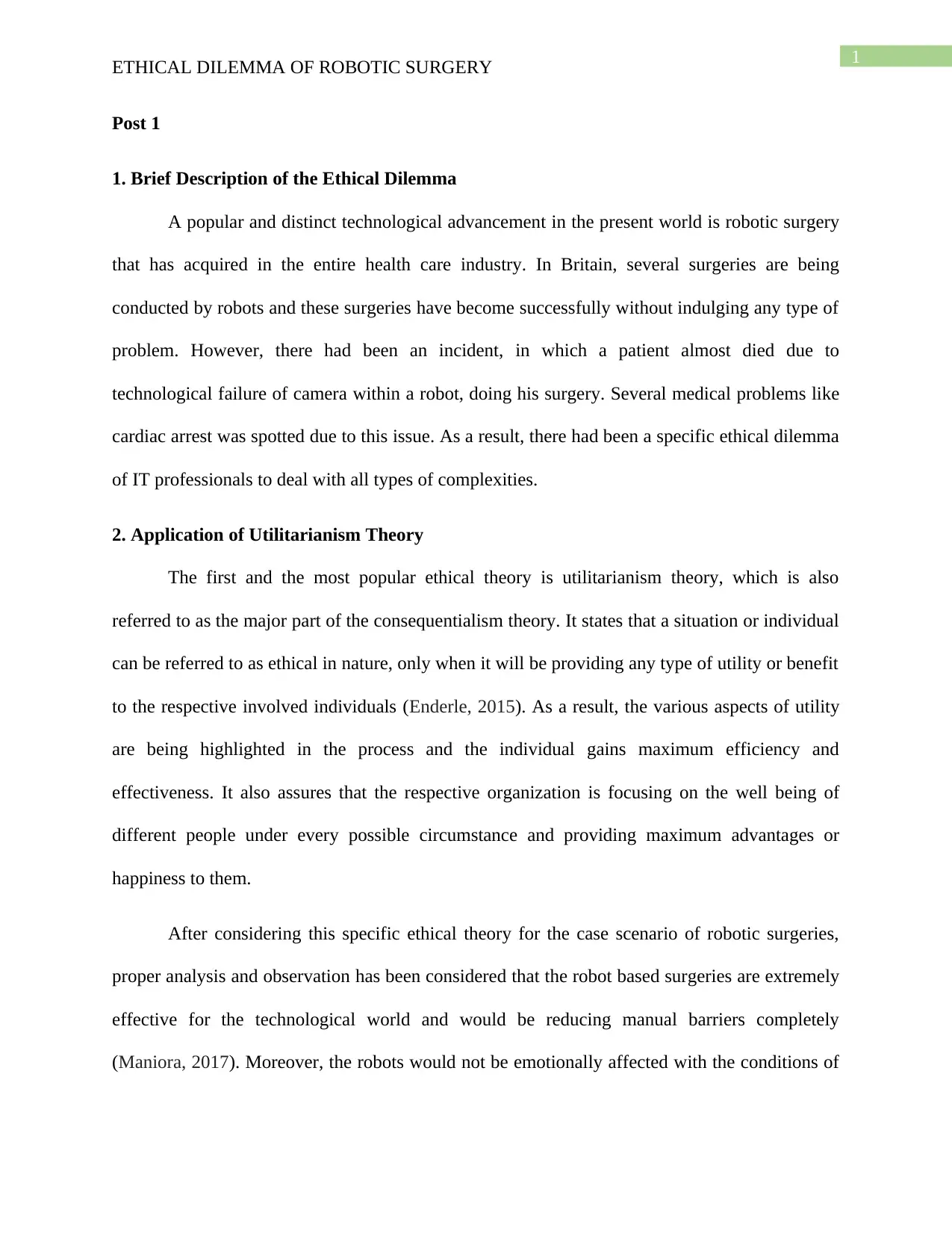
1
ETHICAL DILEMMA OF ROBOTIC SURGERY
Post 1
1. Brief Description of the Ethical Dilemma
A popular and distinct technological advancement in the present world is robotic surgery
that has acquired in the entire health care industry. In Britain, several surgeries are being
conducted by robots and these surgeries have become successfully without indulging any type of
problem. However, there had been an incident, in which a patient almost died due to
technological failure of camera within a robot, doing his surgery. Several medical problems like
cardiac arrest was spotted due to this issue. As a result, there had been a specific ethical dilemma
of IT professionals to deal with all types of complexities.
2. Application of Utilitarianism Theory
The first and the most popular ethical theory is utilitarianism theory, which is also
referred to as the major part of the consequentialism theory. It states that a situation or individual
can be referred to as ethical in nature, only when it will be providing any type of utility or benefit
to the respective involved individuals (Enderle, 2015). As a result, the various aspects of utility
are being highlighted in the process and the individual gains maximum efficiency and
effectiveness. It also assures that the respective organization is focusing on the well being of
different people under every possible circumstance and providing maximum advantages or
happiness to them.
After considering this specific ethical theory for the case scenario of robotic surgeries,
proper analysis and observation has been considered that the robot based surgeries are extremely
effective for the technological world and would be reducing manual barriers completely
(Maniora, 2017). Moreover, the robots would not be emotionally affected with the conditions of
ETHICAL DILEMMA OF ROBOTIC SURGERY
Post 1
1. Brief Description of the Ethical Dilemma
A popular and distinct technological advancement in the present world is robotic surgery
that has acquired in the entire health care industry. In Britain, several surgeries are being
conducted by robots and these surgeries have become successfully without indulging any type of
problem. However, there had been an incident, in which a patient almost died due to
technological failure of camera within a robot, doing his surgery. Several medical problems like
cardiac arrest was spotted due to this issue. As a result, there had been a specific ethical dilemma
of IT professionals to deal with all types of complexities.
2. Application of Utilitarianism Theory
The first and the most popular ethical theory is utilitarianism theory, which is also
referred to as the major part of the consequentialism theory. It states that a situation or individual
can be referred to as ethical in nature, only when it will be providing any type of utility or benefit
to the respective involved individuals (Enderle, 2015). As a result, the various aspects of utility
are being highlighted in the process and the individual gains maximum efficiency and
effectiveness. It also assures that the respective organization is focusing on the well being of
different people under every possible circumstance and providing maximum advantages or
happiness to them.
After considering this specific ethical theory for the case scenario of robotic surgeries,
proper analysis and observation has been considered that the robot based surgeries are extremely
effective for the technological world and would be reducing manual barriers completely
(Maniora, 2017). Moreover, the robots would not be emotionally affected with the conditions of
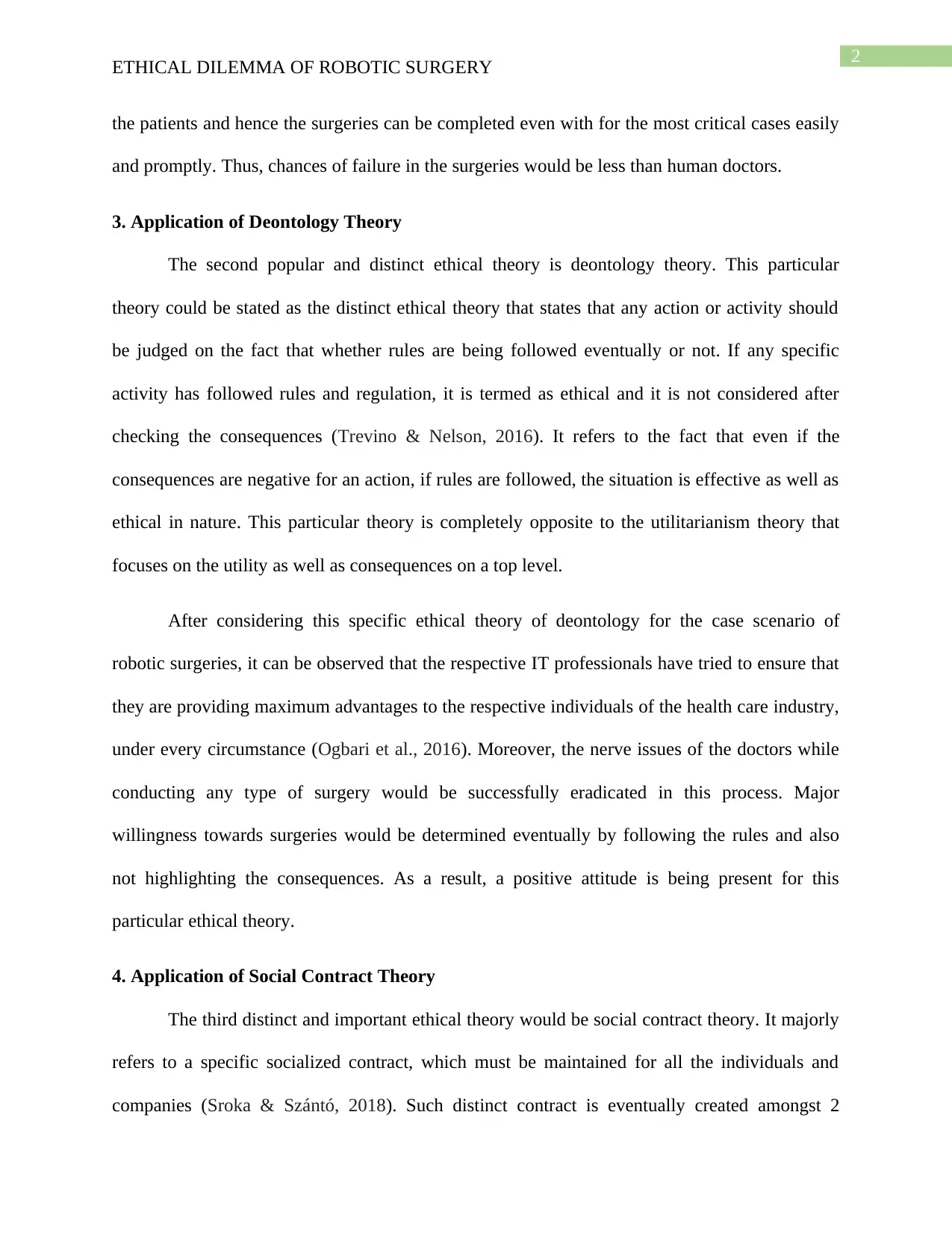
2
ETHICAL DILEMMA OF ROBOTIC SURGERY
the patients and hence the surgeries can be completed even with for the most critical cases easily
and promptly. Thus, chances of failure in the surgeries would be less than human doctors.
3. Application of Deontology Theory
The second popular and distinct ethical theory is deontology theory. This particular
theory could be stated as the distinct ethical theory that states that any action or activity should
be judged on the fact that whether rules are being followed eventually or not. If any specific
activity has followed rules and regulation, it is termed as ethical and it is not considered after
checking the consequences (Trevino & Nelson, 2016). It refers to the fact that even if the
consequences are negative for an action, if rules are followed, the situation is effective as well as
ethical in nature. This particular theory is completely opposite to the utilitarianism theory that
focuses on the utility as well as consequences on a top level.
After considering this specific ethical theory of deontology for the case scenario of
robotic surgeries, it can be observed that the respective IT professionals have tried to ensure that
they are providing maximum advantages to the respective individuals of the health care industry,
under every circumstance (Ogbari et al., 2016). Moreover, the nerve issues of the doctors while
conducting any type of surgery would be successfully eradicated in this process. Major
willingness towards surgeries would be determined eventually by following the rules and also
not highlighting the consequences. As a result, a positive attitude is being present for this
particular ethical theory.
4. Application of Social Contract Theory
The third distinct and important ethical theory would be social contract theory. It majorly
refers to a specific socialized contract, which must be maintained for all the individuals and
companies (Sroka & Szántó, 2018). Such distinct contract is eventually created amongst 2
ETHICAL DILEMMA OF ROBOTIC SURGERY
the patients and hence the surgeries can be completed even with for the most critical cases easily
and promptly. Thus, chances of failure in the surgeries would be less than human doctors.
3. Application of Deontology Theory
The second popular and distinct ethical theory is deontology theory. This particular
theory could be stated as the distinct ethical theory that states that any action or activity should
be judged on the fact that whether rules are being followed eventually or not. If any specific
activity has followed rules and regulation, it is termed as ethical and it is not considered after
checking the consequences (Trevino & Nelson, 2016). It refers to the fact that even if the
consequences are negative for an action, if rules are followed, the situation is effective as well as
ethical in nature. This particular theory is completely opposite to the utilitarianism theory that
focuses on the utility as well as consequences on a top level.
After considering this specific ethical theory of deontology for the case scenario of
robotic surgeries, it can be observed that the respective IT professionals have tried to ensure that
they are providing maximum advantages to the respective individuals of the health care industry,
under every circumstance (Ogbari et al., 2016). Moreover, the nerve issues of the doctors while
conducting any type of surgery would be successfully eradicated in this process. Major
willingness towards surgeries would be determined eventually by following the rules and also
not highlighting the consequences. As a result, a positive attitude is being present for this
particular ethical theory.
4. Application of Social Contract Theory
The third distinct and important ethical theory would be social contract theory. It majorly
refers to a specific socialized contract, which must be maintained for all the individuals and
companies (Sroka & Szántó, 2018). Such distinct contract is eventually created amongst 2
⊘ This is a preview!⊘
Do you want full access?
Subscribe today to unlock all pages.

Trusted by 1+ million students worldwide
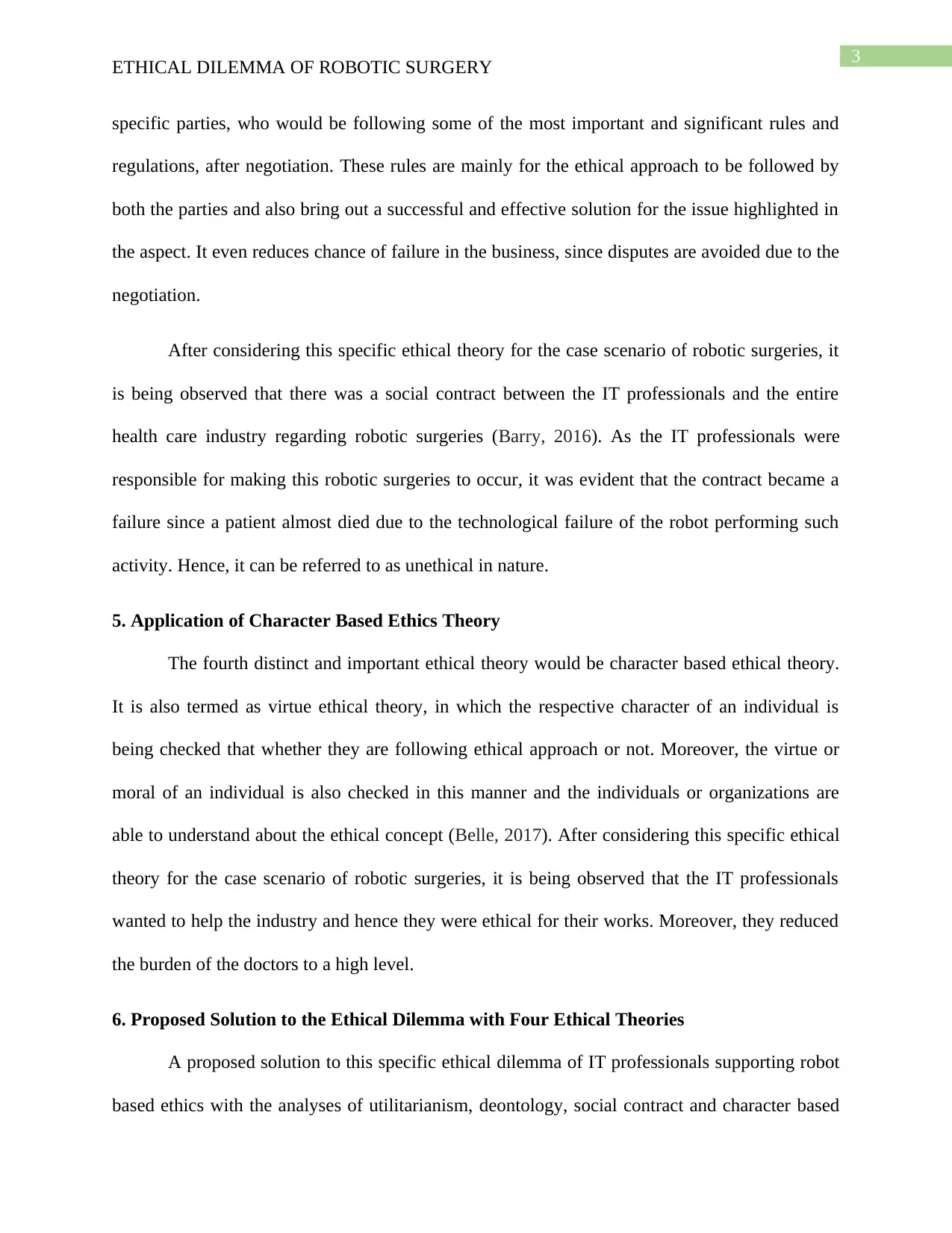
3
ETHICAL DILEMMA OF ROBOTIC SURGERY
specific parties, who would be following some of the most important and significant rules and
regulations, after negotiation. These rules are mainly for the ethical approach to be followed by
both the parties and also bring out a successful and effective solution for the issue highlighted in
the aspect. It even reduces chance of failure in the business, since disputes are avoided due to the
negotiation.
After considering this specific ethical theory for the case scenario of robotic surgeries, it
is being observed that there was a social contract between the IT professionals and the entire
health care industry regarding robotic surgeries (Barry, 2016). As the IT professionals were
responsible for making this robotic surgeries to occur, it was evident that the contract became a
failure since a patient almost died due to the technological failure of the robot performing such
activity. Hence, it can be referred to as unethical in nature.
5. Application of Character Based Ethics Theory
The fourth distinct and important ethical theory would be character based ethical theory.
It is also termed as virtue ethical theory, in which the respective character of an individual is
being checked that whether they are following ethical approach or not. Moreover, the virtue or
moral of an individual is also checked in this manner and the individuals or organizations are
able to understand about the ethical concept (Belle, 2017). After considering this specific ethical
theory for the case scenario of robotic surgeries, it is being observed that the IT professionals
wanted to help the industry and hence they were ethical for their works. Moreover, they reduced
the burden of the doctors to a high level.
6. Proposed Solution to the Ethical Dilemma with Four Ethical Theories
A proposed solution to this specific ethical dilemma of IT professionals supporting robot
based ethics with the analyses of utilitarianism, deontology, social contract and character based
ETHICAL DILEMMA OF ROBOTIC SURGERY
specific parties, who would be following some of the most important and significant rules and
regulations, after negotiation. These rules are mainly for the ethical approach to be followed by
both the parties and also bring out a successful and effective solution for the issue highlighted in
the aspect. It even reduces chance of failure in the business, since disputes are avoided due to the
negotiation.
After considering this specific ethical theory for the case scenario of robotic surgeries, it
is being observed that there was a social contract between the IT professionals and the entire
health care industry regarding robotic surgeries (Barry, 2016). As the IT professionals were
responsible for making this robotic surgeries to occur, it was evident that the contract became a
failure since a patient almost died due to the technological failure of the robot performing such
activity. Hence, it can be referred to as unethical in nature.
5. Application of Character Based Ethics Theory
The fourth distinct and important ethical theory would be character based ethical theory.
It is also termed as virtue ethical theory, in which the respective character of an individual is
being checked that whether they are following ethical approach or not. Moreover, the virtue or
moral of an individual is also checked in this manner and the individuals or organizations are
able to understand about the ethical concept (Belle, 2017). After considering this specific ethical
theory for the case scenario of robotic surgeries, it is being observed that the IT professionals
wanted to help the industry and hence they were ethical for their works. Moreover, they reduced
the burden of the doctors to a high level.
6. Proposed Solution to the Ethical Dilemma with Four Ethical Theories
A proposed solution to this specific ethical dilemma of IT professionals supporting robot
based ethics with the analyses of utilitarianism, deontology, social contract and character based
Paraphrase This Document
Need a fresh take? Get an instant paraphrase of this document with our AI Paraphraser
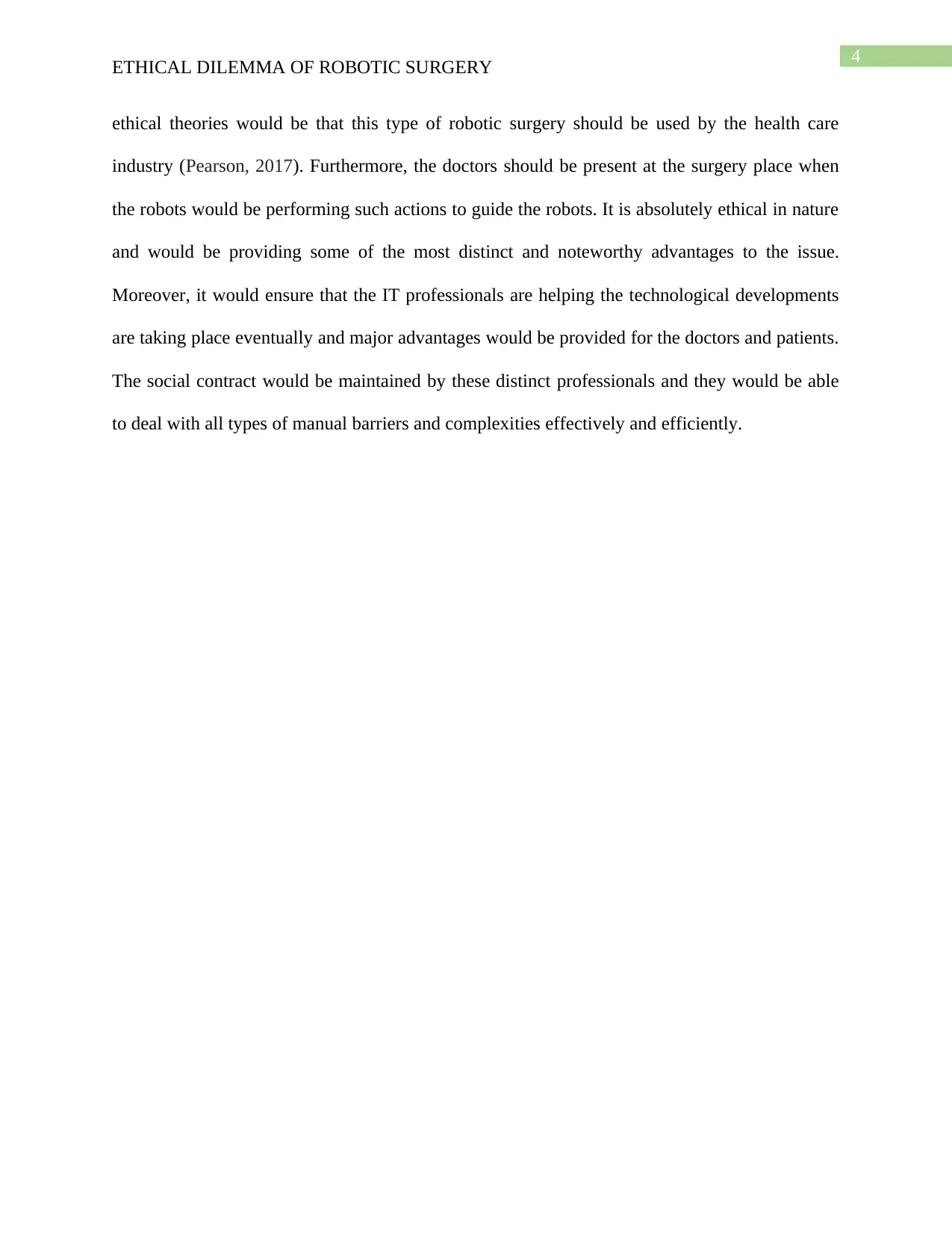
4
ETHICAL DILEMMA OF ROBOTIC SURGERY
ethical theories would be that this type of robotic surgery should be used by the health care
industry (Pearson, 2017). Furthermore, the doctors should be present at the surgery place when
the robots would be performing such actions to guide the robots. It is absolutely ethical in nature
and would be providing some of the most distinct and noteworthy advantages to the issue.
Moreover, it would ensure that the IT professionals are helping the technological developments
are taking place eventually and major advantages would be provided for the doctors and patients.
The social contract would be maintained by these distinct professionals and they would be able
to deal with all types of manual barriers and complexities effectively and efficiently.
ETHICAL DILEMMA OF ROBOTIC SURGERY
ethical theories would be that this type of robotic surgery should be used by the health care
industry (Pearson, 2017). Furthermore, the doctors should be present at the surgery place when
the robots would be performing such actions to guide the robots. It is absolutely ethical in nature
and would be providing some of the most distinct and noteworthy advantages to the issue.
Moreover, it would ensure that the IT professionals are helping the technological developments
are taking place eventually and major advantages would be provided for the doctors and patients.
The social contract would be maintained by these distinct professionals and they would be able
to deal with all types of manual barriers and complexities effectively and efficiently.
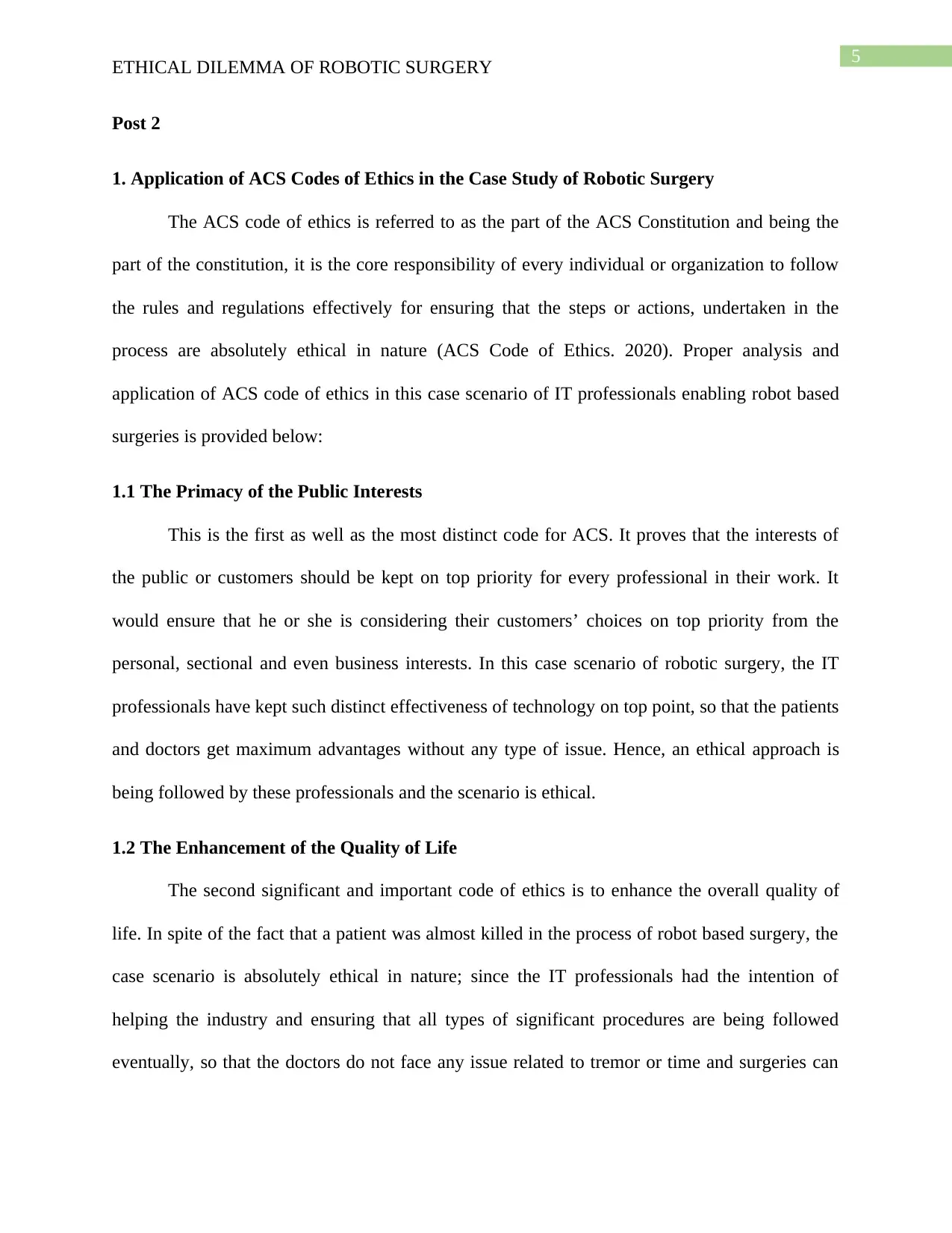
5
ETHICAL DILEMMA OF ROBOTIC SURGERY
Post 2
1. Application of ACS Codes of Ethics in the Case Study of Robotic Surgery
The ACS code of ethics is referred to as the part of the ACS Constitution and being the
part of the constitution, it is the core responsibility of every individual or organization to follow
the rules and regulations effectively for ensuring that the steps or actions, undertaken in the
process are absolutely ethical in nature (ACS Code of Ethics. 2020). Proper analysis and
application of ACS code of ethics in this case scenario of IT professionals enabling robot based
surgeries is provided below:
1.1 The Primacy of the Public Interests
This is the first as well as the most distinct code for ACS. It proves that the interests of
the public or customers should be kept on top priority for every professional in their work. It
would ensure that he or she is considering their customers’ choices on top priority from the
personal, sectional and even business interests. In this case scenario of robotic surgery, the IT
professionals have kept such distinct effectiveness of technology on top point, so that the patients
and doctors get maximum advantages without any type of issue. Hence, an ethical approach is
being followed by these professionals and the scenario is ethical.
1.2 The Enhancement of the Quality of Life
The second significant and important code of ethics is to enhance the overall quality of
life. In spite of the fact that a patient was almost killed in the process of robot based surgery, the
case scenario is absolutely ethical in nature; since the IT professionals had the intention of
helping the industry and ensuring that all types of significant procedures are being followed
eventually, so that the doctors do not face any issue related to tremor or time and surgeries can
ETHICAL DILEMMA OF ROBOTIC SURGERY
Post 2
1. Application of ACS Codes of Ethics in the Case Study of Robotic Surgery
The ACS code of ethics is referred to as the part of the ACS Constitution and being the
part of the constitution, it is the core responsibility of every individual or organization to follow
the rules and regulations effectively for ensuring that the steps or actions, undertaken in the
process are absolutely ethical in nature (ACS Code of Ethics. 2020). Proper analysis and
application of ACS code of ethics in this case scenario of IT professionals enabling robot based
surgeries is provided below:
1.1 The Primacy of the Public Interests
This is the first as well as the most distinct code for ACS. It proves that the interests of
the public or customers should be kept on top priority for every professional in their work. It
would ensure that he or she is considering their customers’ choices on top priority from the
personal, sectional and even business interests. In this case scenario of robotic surgery, the IT
professionals have kept such distinct effectiveness of technology on top point, so that the patients
and doctors get maximum advantages without any type of issue. Hence, an ethical approach is
being followed by these professionals and the scenario is ethical.
1.2 The Enhancement of the Quality of Life
The second significant and important code of ethics is to enhance the overall quality of
life. In spite of the fact that a patient was almost killed in the process of robot based surgery, the
case scenario is absolutely ethical in nature; since the IT professionals had the intention of
helping the industry and ensuring that all types of significant procedures are being followed
eventually, so that the doctors do not face any issue related to tremor or time and surgeries can
⊘ This is a preview!⊘
Do you want full access?
Subscribe today to unlock all pages.

Trusted by 1+ million students worldwide
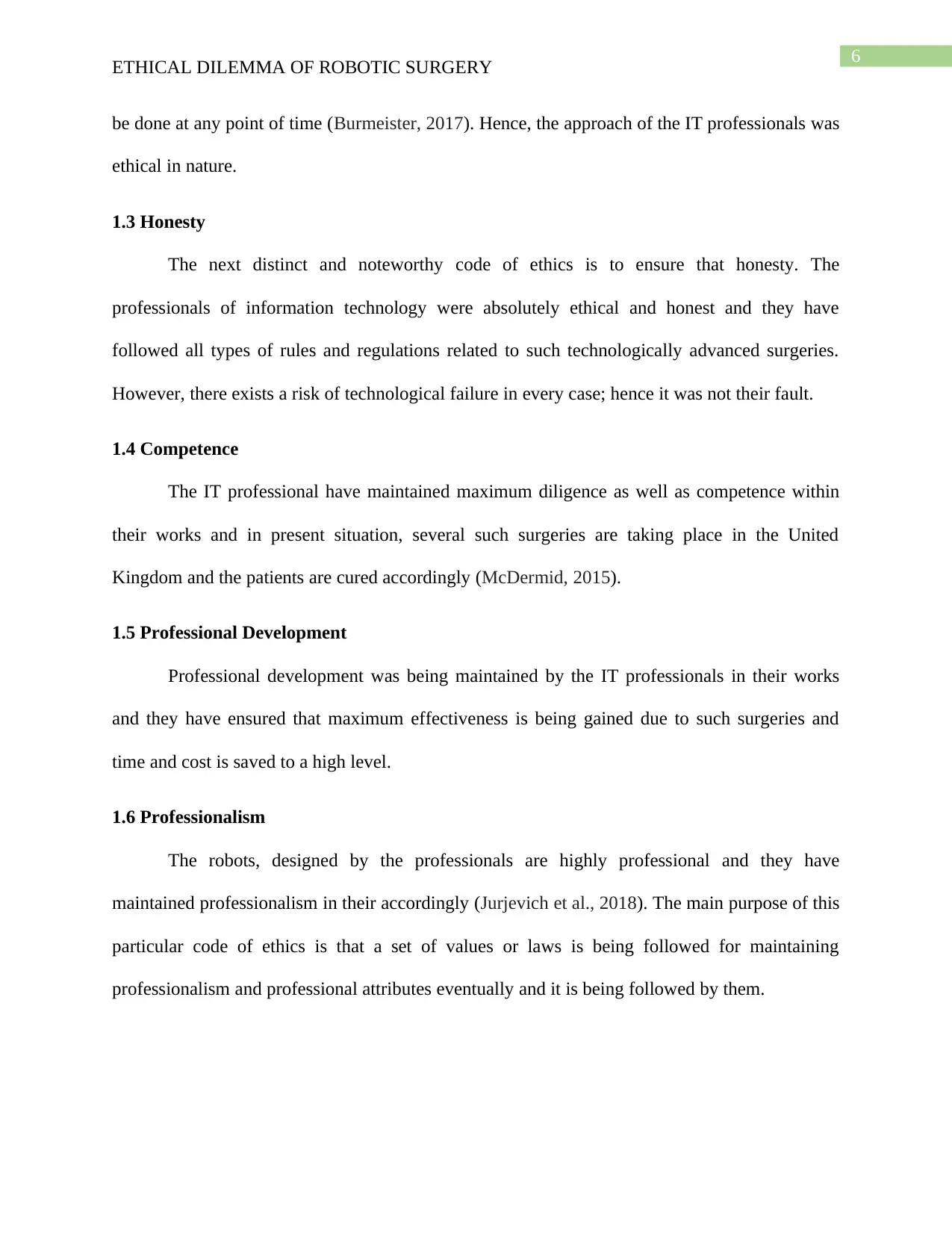
6
ETHICAL DILEMMA OF ROBOTIC SURGERY
be done at any point of time (Burmeister, 2017). Hence, the approach of the IT professionals was
ethical in nature.
1.3 Honesty
The next distinct and noteworthy code of ethics is to ensure that honesty. The
professionals of information technology were absolutely ethical and honest and they have
followed all types of rules and regulations related to such technologically advanced surgeries.
However, there exists a risk of technological failure in every case; hence it was not their fault.
1.4 Competence
The IT professional have maintained maximum diligence as well as competence within
their works and in present situation, several such surgeries are taking place in the United
Kingdom and the patients are cured accordingly (McDermid, 2015).
1.5 Professional Development
Professional development was being maintained by the IT professionals in their works
and they have ensured that maximum effectiveness is being gained due to such surgeries and
time and cost is saved to a high level.
1.6 Professionalism
The robots, designed by the professionals are highly professional and they have
maintained professionalism in their accordingly (Jurjevich et al., 2018). The main purpose of this
particular code of ethics is that a set of values or laws is being followed for maintaining
professionalism and professional attributes eventually and it is being followed by them.
ETHICAL DILEMMA OF ROBOTIC SURGERY
be done at any point of time (Burmeister, 2017). Hence, the approach of the IT professionals was
ethical in nature.
1.3 Honesty
The next distinct and noteworthy code of ethics is to ensure that honesty. The
professionals of information technology were absolutely ethical and honest and they have
followed all types of rules and regulations related to such technologically advanced surgeries.
However, there exists a risk of technological failure in every case; hence it was not their fault.
1.4 Competence
The IT professional have maintained maximum diligence as well as competence within
their works and in present situation, several such surgeries are taking place in the United
Kingdom and the patients are cured accordingly (McDermid, 2015).
1.5 Professional Development
Professional development was being maintained by the IT professionals in their works
and they have ensured that maximum effectiveness is being gained due to such surgeries and
time and cost is saved to a high level.
1.6 Professionalism
The robots, designed by the professionals are highly professional and they have
maintained professionalism in their accordingly (Jurjevich et al., 2018). The main purpose of this
particular code of ethics is that a set of values or laws is being followed for maintaining
professionalism and professional attributes eventually and it is being followed by them.
Paraphrase This Document
Need a fresh take? Get an instant paraphrase of this document with our AI Paraphraser
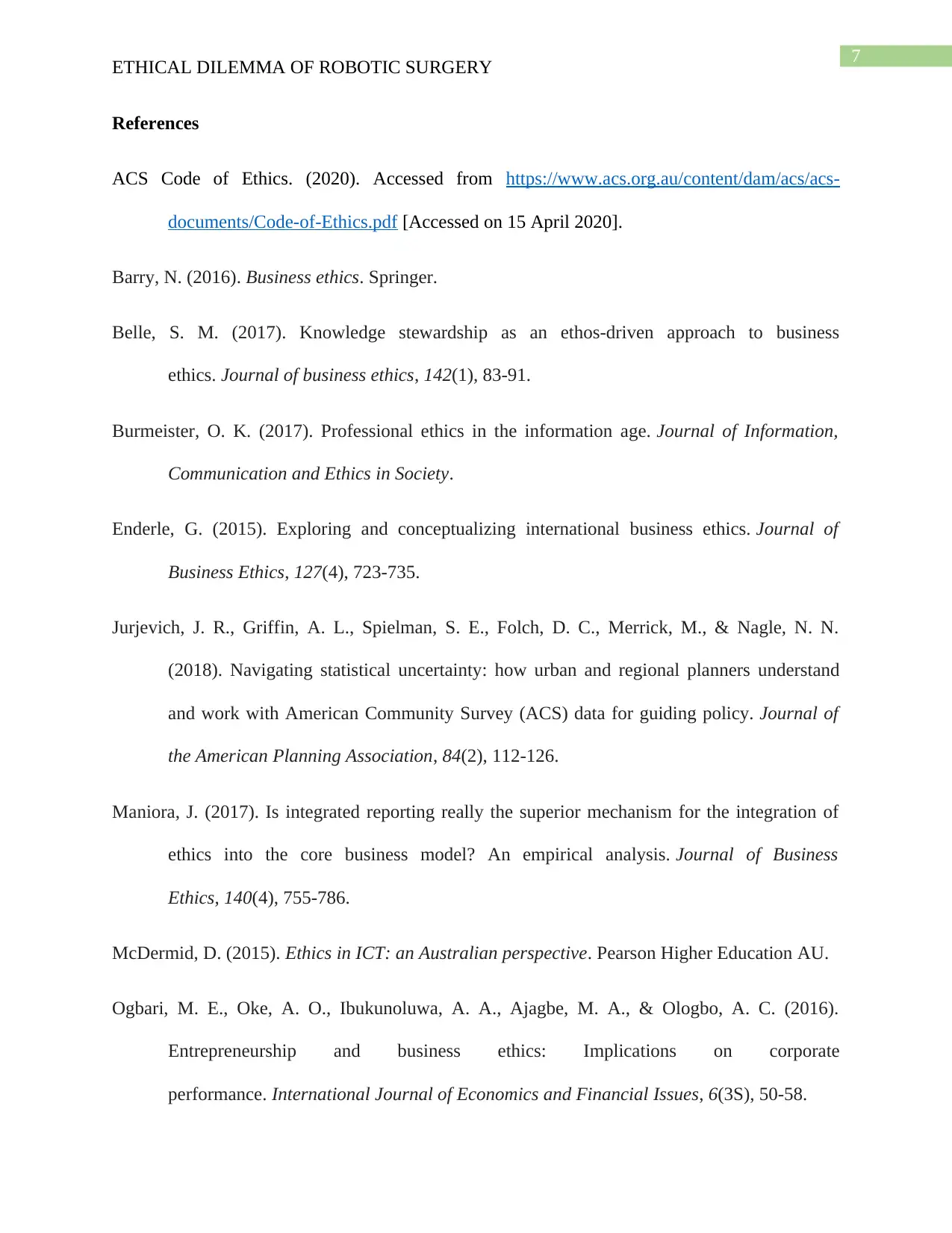
7
ETHICAL DILEMMA OF ROBOTIC SURGERY
References
ACS Code of Ethics. (2020). Accessed from https://www.acs.org.au/content/dam/acs/acs-
documents/Code-of-Ethics.pdf [Accessed on 15 April 2020].
Barry, N. (2016). Business ethics. Springer.
Belle, S. M. (2017). Knowledge stewardship as an ethos-driven approach to business
ethics. Journal of business ethics, 142(1), 83-91.
Burmeister, O. K. (2017). Professional ethics in the information age. Journal of Information,
Communication and Ethics in Society.
Enderle, G. (2015). Exploring and conceptualizing international business ethics. Journal of
Business Ethics, 127(4), 723-735.
Jurjevich, J. R., Griffin, A. L., Spielman, S. E., Folch, D. C., Merrick, M., & Nagle, N. N.
(2018). Navigating statistical uncertainty: how urban and regional planners understand
and work with American Community Survey (ACS) data for guiding policy. Journal of
the American Planning Association, 84(2), 112-126.
Maniora, J. (2017). Is integrated reporting really the superior mechanism for the integration of
ethics into the core business model? An empirical analysis. Journal of Business
Ethics, 140(4), 755-786.
McDermid, D. (2015). Ethics in ICT: an Australian perspective. Pearson Higher Education AU.
Ogbari, M. E., Oke, A. O., Ibukunoluwa, A. A., Ajagbe, M. A., & Ologbo, A. C. (2016).
Entrepreneurship and business ethics: Implications on corporate
performance. International Journal of Economics and Financial Issues, 6(3S), 50-58.
ETHICAL DILEMMA OF ROBOTIC SURGERY
References
ACS Code of Ethics. (2020). Accessed from https://www.acs.org.au/content/dam/acs/acs-
documents/Code-of-Ethics.pdf [Accessed on 15 April 2020].
Barry, N. (2016). Business ethics. Springer.
Belle, S. M. (2017). Knowledge stewardship as an ethos-driven approach to business
ethics. Journal of business ethics, 142(1), 83-91.
Burmeister, O. K. (2017). Professional ethics in the information age. Journal of Information,
Communication and Ethics in Society.
Enderle, G. (2015). Exploring and conceptualizing international business ethics. Journal of
Business Ethics, 127(4), 723-735.
Jurjevich, J. R., Griffin, A. L., Spielman, S. E., Folch, D. C., Merrick, M., & Nagle, N. N.
(2018). Navigating statistical uncertainty: how urban and regional planners understand
and work with American Community Survey (ACS) data for guiding policy. Journal of
the American Planning Association, 84(2), 112-126.
Maniora, J. (2017). Is integrated reporting really the superior mechanism for the integration of
ethics into the core business model? An empirical analysis. Journal of Business
Ethics, 140(4), 755-786.
McDermid, D. (2015). Ethics in ICT: an Australian perspective. Pearson Higher Education AU.
Ogbari, M. E., Oke, A. O., Ibukunoluwa, A. A., Ajagbe, M. A., & Ologbo, A. C. (2016).
Entrepreneurship and business ethics: Implications on corporate
performance. International Journal of Economics and Financial Issues, 6(3S), 50-58.
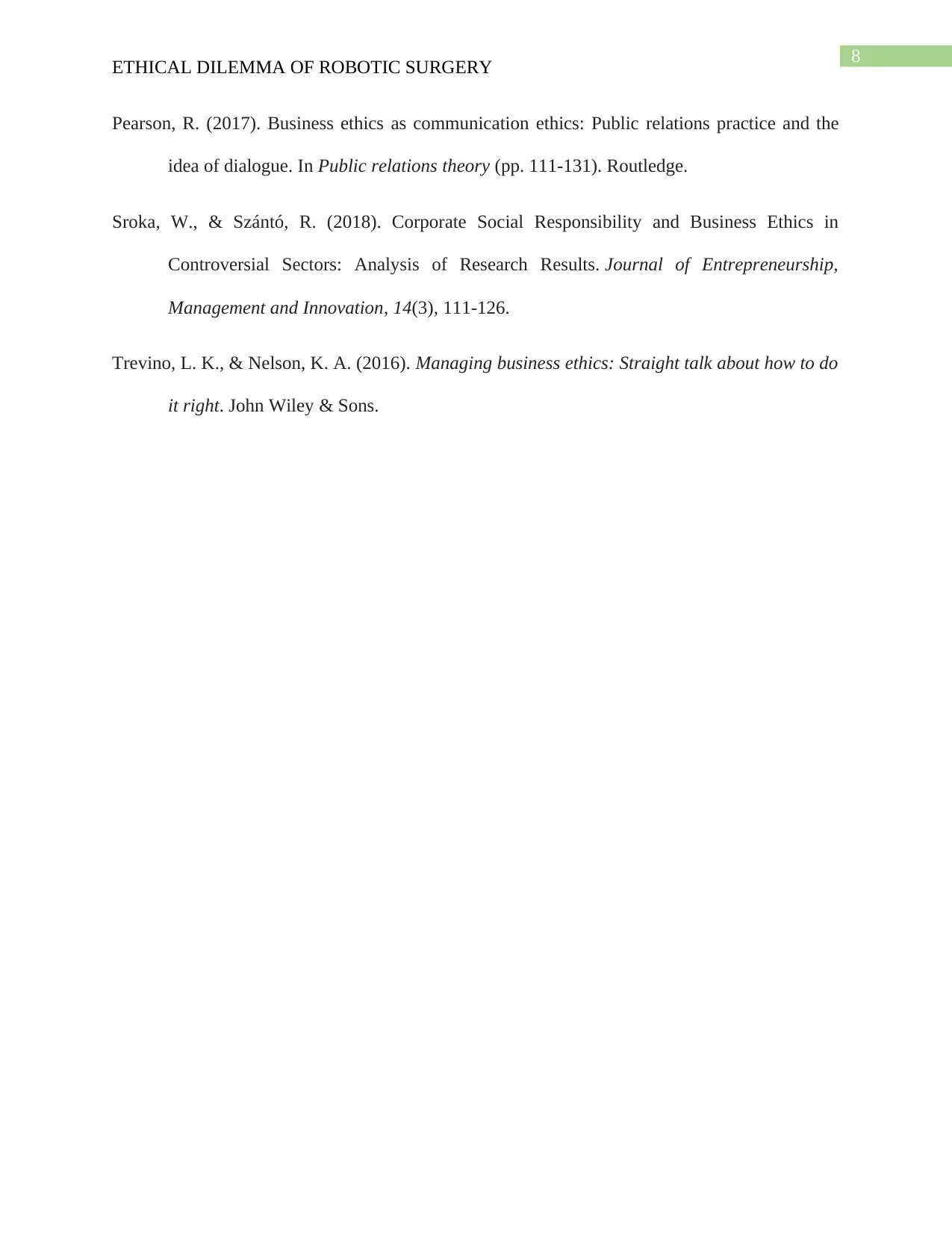
8
ETHICAL DILEMMA OF ROBOTIC SURGERY
Pearson, R. (2017). Business ethics as communication ethics: Public relations practice and the
idea of dialogue. In Public relations theory (pp. 111-131). Routledge.
Sroka, W., & Szántó, R. (2018). Corporate Social Responsibility and Business Ethics in
Controversial Sectors: Analysis of Research Results. Journal of Entrepreneurship,
Management and Innovation, 14(3), 111-126.
Trevino, L. K., & Nelson, K. A. (2016). Managing business ethics: Straight talk about how to do
it right. John Wiley & Sons.
ETHICAL DILEMMA OF ROBOTIC SURGERY
Pearson, R. (2017). Business ethics as communication ethics: Public relations practice and the
idea of dialogue. In Public relations theory (pp. 111-131). Routledge.
Sroka, W., & Szántó, R. (2018). Corporate Social Responsibility and Business Ethics in
Controversial Sectors: Analysis of Research Results. Journal of Entrepreneurship,
Management and Innovation, 14(3), 111-126.
Trevino, L. K., & Nelson, K. A. (2016). Managing business ethics: Straight talk about how to do
it right. John Wiley & Sons.
⊘ This is a preview!⊘
Do you want full access?
Subscribe today to unlock all pages.

Trusted by 1+ million students worldwide
1 out of 9
Related Documents
Your All-in-One AI-Powered Toolkit for Academic Success.
+13062052269
info@desklib.com
Available 24*7 on WhatsApp / Email
![[object Object]](/_next/static/media/star-bottom.7253800d.svg)
Unlock your academic potential
Copyright © 2020–2025 A2Z Services. All Rights Reserved. Developed and managed by ZUCOL.





